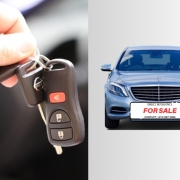Selling Your Used Car Safely: Private Sale & Trade-In Guide
Selling your used vehicle can be a rewarding process when done correctly. Whether you want to get the highest price or complete the sale quickly, preparation and knowledge are key. This guide will walk you through the essential steps, from deciding how to sell to finalizing the deal safely.
1. Decide Between Trading In or Selling Privately
Trade-In: A Convenient but Lower Offer
Trading your car at a dealership is the easiest option. The dealership handles all the paperwork, repairs, and marketing, allowing you to walk away with a quick sale. However, dealerships aim to resell your vehicle for a profit, which means they may offer less than the market value.
Here’s what affects a dealership’s offer:
- Reconditioning costs – The dealer will deduct the cost of necessary repairs, detailing, and touch-ups from your car’s value.
- Profit margin – The dealer factors in their expected profit before making you an offer.
- Demand for your car – If your car is a sought-after model, you may get a better offer.
Private Sale: More Money, More Effort
Selling your vehicle privately allows you to set your own price and potentially earn more than a dealer would offer. However, it requires more effort, including:
- Advertising your car effectively
- Handling inquiries and test drives
- Negotiating with potential buyers
- Completing the paperwork yourself
2. Determine Your Car’s Market Value
How to Find Your Car’s Value
To price your car competitively:
- Check online marketplaces – Look at listings for similar makes, models, and mileage on sites like AutoTrader, Kijiji, and local classified ads.
- Use a valuation tool – VinAudit Canada’s Market Value Tool provides accurate market pricing based on actual sales data.
- Factor in history and condition – A vehicle history report from VinAudit Canada can show past accidents, title status, and service records, all of which impact value.
What Affects Your Car’s Value?
- Accident history – Vehicles with a clean history typically sell for more.
- Mileage – Lower mileage cars fetch higher prices.
- Service records – A well-maintained vehicle with documented service history is more attractive to buyers.
- Exterior and interior condition – Scratches, dents, and upholstery wear affect value.
- Features and upgrades – Vehicles with extra features like leather seats, sunroofs, or premium sound systems often command higher prices.
3. Prepare Your Vehicle for Sale
Steps to Prepare Your Car:- Thoroughly Clean It – Wash the exterior, wax it, vacuum the interior, and remove personal belongings.
- Fix Minor Issues – Replace burned-out bulbs, top up fluids, and fix minor scratches or dents.
- Service Your Car – If possible, get a professional inspection and address any major concerns.
- Gather Important Documents – Have your title, service records, owner’s manual, and safety certificates ready.
4. Create an Effective Listing
What to Include in Your Ad
- High-quality photos – Take pictures from multiple angles, including the front, rear, sides, interior, engine bay, and dashboard.
- Detailed description – Include year, make, model, mileage, condition, and any upgrades.
- Price – Set a competitive price based on market research.
- VIN and history report – Providing a VinAudit Canada Vehicle History Report increases buyer confidence.
5. Manage Inquiries and Test Drives Safely
Screening Buyers:- Avoid lowball offers or people who seem uninterested in meeting in person.
- Be cautious of scammers asking for personal information.
- Meet in public, well-lit locations, like a police station parking lot.
Test Drive Guidelines
- Always accompany the buyer on the test drive.
- Check their driver’s license before handing over the keys.
- Stick to a planned route to avoid unnecessary detours.
6. Negotiate and Close the Sale
How to Handle Negotiations:- Know your lowest acceptable price and be firm.
- Be prepared to justify your asking price with documentation (vehicle history, maintenance records, etc.).
Secure Payment Safely
- Accept cash or a certified bank draft. Avoid personal checks and wire transfers to prevent fraud.
- Meet at the bank if necessary to verify the funds.
7. Finalize the Sale and Transfer Ownership
Steps to Complete the Sale:- Sign a bill of sale – This serves as a legal record of the transaction.
- Remove your license plates – In most provinces, plates do not transfer with the vehicle.
- Provide necessary documents – Hand over the title, registration, and any required safety certificates.
- Cancel your insurance – Notify your insurer to stop coverage on the sold vehicle.
- Notify your local motor vehicle authority – Ensure the vehicle is no longer in your name.
Making Your Car Sale Simple and Secure
Selling your used vehicle doesn’t have to be complicated. Whether you choose to trade it in for convenience or sell it privately for a higher price, following these steps will help you get the best deal while ensuring a smooth transaction.
For extra peace of mind, get a VinAudit Canada Vehicle History Report to prove your car’s history and make your listing more attractive to buyers.
By taking the right steps, you can sell your car with confidence and maximize your return.


